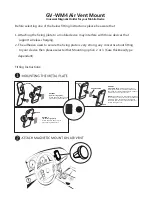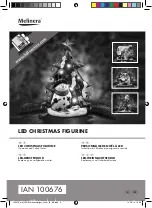
9
8
Pr
Pr
Pr
Pr
Problem
oblem
oblem
oblem
oblem
No picture on TV2
Bad quality picture
or sound on TV2
No sound or picture on
TV2
No picture on TV2
(VCR is used as a video
source)
Initially good picture,
disappears after several
minutes.
(VCR is used to view a
cable Programme)
Wrong picture on TV2
No control of Video
sources from TV2
Wrong picture on TV1
Troubleshooting
First, check all cables to ensure that they are connected correctly.
Solution
Solution
Solution
Solution
Solution
• Ensure that both units are switched on (figure A-5 and B-11 are green).
• Select the EXT. or AV channel on TV2.
• Activate the video source you would like to watch (set-top box: power on; VCR/DVD:
playback).
• Select the correct video source on the Transmitter unit using the input selection
buttons (figure B-14).
• Select the same channel on both the Receiver and Transmitter units (figure A-2, B-8).
• Move the Receiver unit around, centimetre by centimetre until you get good picture
and sound quality.
• Move the Transmitter unit around until you get good picture and sound.
• Put the SCART
output mode switch (figure B-1, B-9) of an unused SCART output
connector in the
position.
• Put the SCART
output mode switch (figure B-1, B-9) of a used SCART output
connector in the
position.
• Change both units to another channel (figure A-2, B-8). Select the same channel on
both the Receiver and Transmitter units.
• Make sure the input selector switch (figure B-14) is in the correct position (pressed
in).
• Ensure that the correct SCART connector of the VCR is being used. (Ext. 1 or Ext. 2.
Check VCR’s user manual).
• Disable the auto standby mode of the VCR. (Check VCR’s user manual).
• Select the EXT. or AV channel on TV2.
• Select another video source on the Transmitter unit using the input selection
buttons
(figure B-14).
• Activate the video source you would like to watch (set-top box: power on; VCR/DVD:
playback).
• Swap the SCART connectors on the transmitter unit; they might be mixed up (figure
B-3, B-5).
• You may be picking up a signal from another Wireless TV Link. Switch to another
channel on both Receiver unit and Transmitter unit (figure A-2, B-8) to receive your
own signal. Ensure that the same channel is selected on both units!
• Align the Transmitter unit with the video source(s) you want to control (see figure C).
• Install the remote control extender cord.
• Ensure that you are using the remote control of the device you want to control.
• Make sure the Transmitter and Receiver units are placed more then 5 metres apart.
• Reposition the remote control extender cord eye on the video source, or place it 5-10
cm in front of the video source.
• Aim the remote control directly at the Receiver unit and ensure that there are no
obstacles in between. (figure A-7 must be flashing)
• Ensure that there is no other wireless device (e.g. headphones) interfering with the
remote control.
• The maximum operating distance between the remote control and the Receiver unit is
7 metres*; be sure you are within this range.
• Select the correct EXT. or AV channel on TV1 (see TV instruction manual).
• Select a regular programme number.
•
Move the Receiver unit around, centimetre by centimetre, until the buzzing sound
disappears.
•
Move the Transmitter unit around, centimetre by centimetre, until the buzzing sound
disappears.
•
In some cases you will not be able to solve this problem.
•
Select the corresponding EXT or AV channel on TV1.
•
Check that both your TV and VCR support this feature. (Check the TV and VCR’s
user manuals)
•
Use Easylink compatible or fully wired SCART cables.
•
Select CVBS video output format for your S-VHS VCR. (Check the VCR’s user
manual)
•
Select CVBS video output format for your DVD player. (Check the DVD player’s user
manual)
Buzzing sound
when using the remote
control
VCR, DVD, SAT is not
selected on the TV if
switched on
‘Easylink’ feature
doesn’t work
S-VHS video gives black
& white pictures only on
either TV1 or TV2
DVD player gives no
pictures on either TV 1
or TV2
Specifications
General
Dimensions:
204 (W) x 168 (D) x 65 (H) mm
Power supply:
220 - 240V AC / 50Hz via power adapters
Operating consumption:
3 W (both transmitter and receiver unit)
Transmitter unit connections: SCART 1 input / output: Stereo Audio / CVBS Video. Supports
‘Easylink’
SCART 2 input / output: Stereo Audio / CVBS Video. Supports
‘Easylink’
Receiver unit connections:
SCART output: Stereo Audio / CVBS Video
Video standards supported:
PAL / NTSC / SECAM
Operating range:
Up to 100m in open air; up to 30m in house
Number of input devices:
2
Audio / Video transmission
Carrier frequency:
2.4 GHz
Number of channels:
4 (may be less, depending on local regulations)
Type of modulation:
FM
Transmission power:
<10mW
Antennas:
Built-in
Remote Control Extender
Carrier frequency:
433.92 MHz
Type of modulation:
AM
Transmission power:
<10mW
Range of IR reception:
Up to 7 metres max.
Carrier frequency range
32kHz – 40 kHz
Remote control extender cord:
Yes, 2 IR eyes
Remote control extender antenna:
Antennas at rear of both units
* depends on remote control’s signal strength and battery condition
Pr
Pr
Pr
Pr
Problem
oblem
oblem
oblem
oblem
Solution
Solution
Solution
Solution
Solution
Содержание SBC VL1200
Страница 51: ...99 98 ...
Страница 52: ...100 ...







































